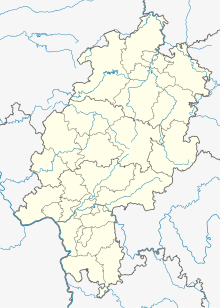Elber mark
Coordinates: 51 ° 13 ′ 19 ″ N , 9 ° 12 ′ 0 ″ E
The Elber Mark was a mark cooperative in the area of today's districts of Elbenberg and Altendorf , both districts of Naumburg in the northern Hessian district of Kassel .
In 1266 the selling precious free Wittekind of Naumburg, canon in Magdeburg and canon in Halberstadt , with the consent of his nephews, the castle in Naumburg and in Wolfhagen location Weidelsburg to Archbishop Werner of Mainz . Also included in this sale was the nearby court "Hagebuche" pledged to the Naumburgers by the Landgraves of Hesse , but with the express confirmation of the Landgrave's right to redeem. According to Georg Landau , this dish under a hornbeam was the Elben dish . The pledge was not redeemed by the landgraves, and so the area of the court became part of the Mainz office of Naumburg.
Excluded from the sale were the villages of Elben, with Elberberg, Altendorf and Beltershausen , which had already come into the possession of the St. Alban Abbey near Mainz (when is not known) and were thereby freed from secular jurisdiction and became their own court. The monastery established the Lords of Elves , who were first recorded in 1231, as governors. The Märker in Elves, Altendorf and Beltershausen be in 1440 in a Weistum testified as the actual owner of the Mark Elber, with the Lords of hereditary same as Mark masters and Greben of Elves as a Mark Masters. The "Mark zum Haine" with the deserted Todtenhausen also belonged to the Elber Mark.
There were repeated disputes over forest use rights in the Elber Mark, especially in the years 1440 to 1441 between Reinhard von Dalwigk and Werner von Elben , which finally culminated in the bloody clashes of the federal rulers' feud in the years 1453-1454 .
At the beginning of the 16th century, the Lords of Elves no longer regarded themselves as bailiffs, but as owners of the forest in the Mark.
When the Lords of Elben and Konrad (Kurt) von Elben died out in the male line in 1535, the Elber Mark first came to Jakob von Taubenheim . This led to protests on the part of the heirs of the last Lord of Elves, which were cleared up as early as 1537; the Elber Mark came now in inheritance to the lords of Boyneburg called von Hohenstein and the lords of Buttlar .
References and comments
- ↑ Landgrafen Regesten online ( page no longer available , search in web archives ) Info: The link was automatically marked as defective. Please check the link according to the instructions and then remove this notice.
- ^ According to Landau's description of the Hessengau , the following places and fields belonged to the Elben court at the time of sale: Elben , Burg and Tal Elberberg , Altenburg , Altendorf , Beltershausen , Dippelshausen, Gershausen , Mandangishein, and Todtenhausen.
- ↑ Whether Jakob von Taubenheim was married to a woman from the family of Elben is not known, but in view of the enfeoffment it is possible.
- ↑ Friedrich Küch, Political Archive of Landgrave Philip the Magnanimous of Hesse , Hirzel, Leipzig, 1910 (p. 688)
Web links
- Georg Landau, Description of the Hessengau , Döll & Schäffer, Kassel, 1857 (pp. 202–204)
- Carl Heßler, Hessische Landes- und Volkskunde , Volume I, second half, Elwert, Marburg, 1907 (p. 172)
- "Weisthümer, collected by G. Landau", in the journal of the Association for Hessian History and Regional Studies , Volume Two, Kassel, 1840 (pp. 242–247)
- "Elben, District of Kassel". Historical local dictionary for Hessen. In: Landesgeschichtliches Informationssystem Hessen (LAGIS).
- Weisthümer , collected by Jacob Grimm, Third Part, Dieterichsche Buchhandlung, Göttingen, 1842 (p. 321–324)
